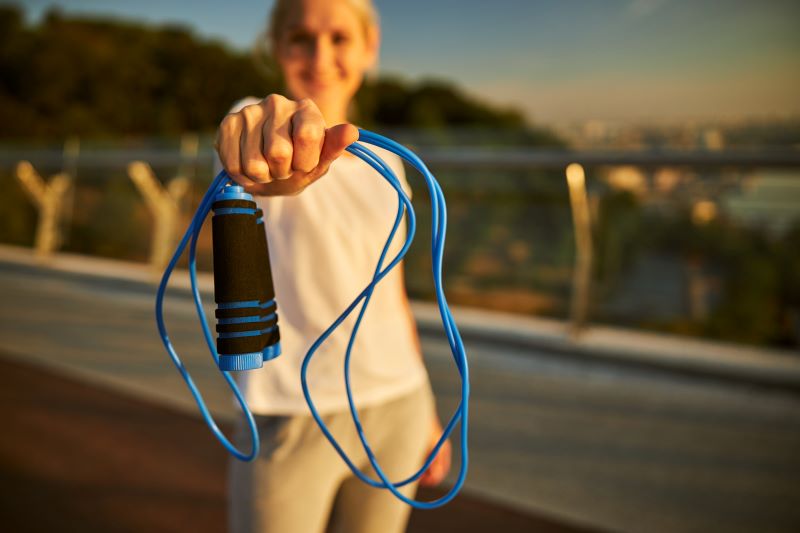Top 12 Benefits of Skipping Rope Daily

A Harvard Health report compared the effects of jumping rope and running. It found that skipping rope for weight loss was comparable to the effects of running for various body weights. Skipping rope is a very efficient cardio exercise that not only aids in weight loss but will also help you improve cardiovascular health, enhance coordination, and also tones muscles throughout the body.
This versatile workout, which can be performed anywhere, makes it an excellent option for those who have limited space or time in their daily routine. Hence, you can opt for the second-best option and skip rope if you do not have the space to run. And, this article answers all your queries regarding 'Is jump rope good for weight loss?'

Table of Contents

Is Jumping/Skipping Rope Good for Weight Loss?
Skipping rope for weight loss is highly recommended. It helps burn off calories very quickly and is also good for the heart. It also strengthens the upper and lower body. That said, results vary from person to person.
Skipping is a cardio exercise preferred by athletes. It helps tone calves and tightens the core. In addition, it improves lung capacity and builds stamina.
What Type of Fats Can be Reduced Through Skipping Rope?
Skipping or jumping rope is known to help reduce both subcutaneous and visceral fat, which are present in our bodies. Given below are the main types of fat that can be reduced through skipping rope, along with their descriptions:
- Subcutaneous Fat: This type of fat is located just beneath the skin and is visibly seen as body fat. Regular skipping helps burn this fat, resulting in a more toned and lean appearance.
- Visceral Fat: Surrounding internal organs, visceral fat is associated with health issues like diabetes and heart disease. High-intensity exercises such as skipping rope significantly reduce visceral fat, improving overall health and lowering the risk of chronic diseases.
Through consistent skipping, anyone can achieve a balanced reduction in both types of these fats, enhancing their physical appearance as well as internal health.
12 Benefits of Skipping Rope for Weight Loss

There are many benefits of using a skipping rope for weight loss. It helps to -
1. Burn Calories
Jumping rope helps to burn calories. For example, jumping rope can help a 125 lb person lose 340 calories in 30 minutes. Hence, it is a high-intensity workout that can lead to faster weight loss.
2. Shed Extra Kilograms
Since jumping rope helps shed around 200 to 300 calories in 15 minutes, it is useful for shedding several kilograms of body weight.
3. Decrease Belly Fat
Skipping rope for weight loss helps to strengthen the core. Therefore, it aids in the building of abs and other core muscles of your body.
4. Improve Cardiovascular Health
Skipping rope is an excellent cardiovascular exercise that increases heart rate, improves overall heart health and reduces the risk of heart disease.
5. Enhance Coordination and Balance
Regular skipping improves coordination, agility, and balance by engaging various muscle groups and requiring precise timing.
6. Increase Stamina and Endurance
Jumping rope builds stamina and endurance, enabling longer and more intense workout sessions over time.
7. Strengthen Muscles
Skipping rope tones and strengthens muscles in the legs, arms, and core, contributing to a more sculpted physique.
8. Boost Mental Health
Engaging in regular physical activity like skipping rope releases endorphins, which can help reduce stress, anxiety, and depression.
9. Improve Bone Density
Jumping rope is a weight-bearing exercise that can help improve bone density, reducing the risk of osteoporosis and fractures.
10. Enhance Flexibility
Regular skipping can increase flexibility and range of motion in the muscles and joints, promoting better overall mobility.
11. Save Time
Skipping rope is a time-efficient workout that can be performed in short bursts, making it ideal for those with busy schedules.
12. Accessibility and Convenience
A skipping rope is inexpensive and portable, allowing you to exercise virtually anywhere without the need for specialised equipment or a gym membership.
Skipping rope has numerous benefits for weight loss, such as increasing cardiovascular health, burning calories, and improving coordination. It is clear that skipping rope works different muscle groups from head to toe, enhancing overall strength and fitness. Let us now explore the effects of this exercise on different body parts.
Body Parts & Muscles Impacted by Skipping Rope Exercise
By skipping rope for weight loss, the body parts which are affected are:
Body Part |
Description |
| Deltoids | The deltoid muscles in the shoulders are engaged, helping to tone and strengthen the upper body. |
| Hamstrings | Skipping targets the hamstrings in the back of the thighs, improving muscle strength and flexibility. |
| Abdominals | The core muscles are activated during skipping, which helps to tighten and tone the abdominal region. |
| Glutes | The gluteal muscles are worked out, leading to a firmer and more sculpted backside. |
| Quadriceps | The quadriceps in the front of the thighs are heavily engaged, contributing to stronger and leaner legs. |
This comprehensive workout targets multiple muscle groups, providing a full-body exercise that enhances overall strength and fitness.
How Long Should You Skip Every Day to Lose Weight?
The American Council on Exercise observes that a person weighing 70 kg can burn up to 450 calories from 30 minutes of skipping. Hence, to lose weight, try a skipping session of around 30 minutes. This caloric expenditure makes skipping rope a highly efficient form of cardiovascular exercise for weight loss.
Frequent skipping improves cardiovascular fitness, tones muscles, increases metabolism, and helps burn calories. Combining your skipping routine with a balanced diet and other forms of exercise can further enhance weight loss and overall health.
How Many Calories are Burned in Skipping Rope?
Just one minute of skipping rope can burn 10 calories while toning various muscle groups, including the legs, buttocks, shoulders, abdomen, and arms. Thus, skipping rope is an effective method for calorie burning.
Engaging in 10-minute skipping sessions daily yields an average calorie burn of 200, surpassing the effectiveness of brisk walking.
Incorporating this dynamic exercise into your routine promotes calorie expenditure and enhances cardiovascular fitness, making it a versatile and efficient addition to any workout regimen.
What Time of the Day is Better for Skipping Rope to Lose Weight?
Specifically, there is no particular time of day that is significantly better for skipping. However, some research shows that exercising at 6 PM is the best for the body as the limbs are the most supple and flexible around this hour. Hence, you can shift your exercise routine to the evening.
That said, there is insufficient evidence on the entire topic to provide concrete information on the subject.
How to Avoid Injuries When Skipping Rope to Lose Weight Faster?
Skipping rope for weight loss may seem like a great idea. However, it is prone to injuries if you do not skip the right way. Hence, avoid the following points for a safe workout:
1. Choosing the Long Skipping Rope
The skipping rope should be as long as your shoulder when it is folded over. The handles should not be too heavy or light. Therefore, choose the right length of rope to make jumping over it easier and safer.
2. Choose an Even Surface
Do not jump rope on a rough or uneven surface to avoid injuries. A hard floor is preferred as your knees receive an extra bounce and do not have to experience much strain.
3. Avoid Jumping with a Hunched Back
Shoulders must be kept back in this exercise as the maximum impact is supposed to reach the buttocks and the hamstring. Jumping with a hunched back may lead to problems, and you will not get the best results from this exercise.
4. Avoid Jumping too High
The goal of weight loss by using skipping rope is to jump rope faster and not higher. Moreover, the effects of this exercise are lost as there is more impact on your ankles and knees. Hence, jump not more than 1 to ½ inches above the ground.
In conclusion, can you lose weight by jumping rope? Yes! However, since it is also an aerobic exercise, you can lose more weight quickly than, for instance, walking. Hence, choose this form of a full-body workout and lose all the belly fat at the earliest!
Techniques for Effective Skipping

Skipping rope is a versatile and efficient exercise, but to maximise its benefits, it's important to use proper techniques. Here are some key techniques for effective skipping:
- Choose the Right Rope: Ensure your rope is the correct length. When you stand on the middle of the rope, the handles should reach your armpits.
- Proper Warm-Up: Begin with a light warm-up to prepare your muscles. This can include dynamic stretches or light cardio activities.
- Maintain Good Posture: Keep your head up, back straight, and shoulders relaxed. Your elbows should be close to your sides, and the movement should come from your wrists, not your arms.
- Soft Landings: Land softly on the balls of your feet to minimise impact on your joints. Keep your knees slightly bent to absorb the shock.
- Controlled Movements: Focus on small, controlled jumps. Aim to jump just high enough for the rope to pass under your feet.
- Steady Breathing: Maintain a steady breathing pattern to ensure your muscles receive enough oxygen.
How to Add Jumping Rope to Your Workout Program?
Incorporating jumping rope into your workout routine can enhance your overall fitness. Here's how to do it effectively:
- Start with the Basics: Begin with basic jumps to get comfortable with the rhythm and coordination required for skipping. Focus on maintaining a steady pace and proper form during the first few sessions.
- Warm-Up Routine: A 5-10 minutes skipping session at a moderate pace is an excellent way to increase your heart rate and prepare your muscles for more intensive workouts.
- High-Intensity Interval Training (HIIT): Alternate between 30-60 seconds of high-intensity skipping and 30-60 seconds of rest or low-intensity exercises like walking or light jogging. Repeat for 15-20 minutes.
- Cool Down and Stretch: After a skipping session, cool down with 5-10 minutes of light activity, such as walking or gentle jogging, followed by stretching. This helps reduce muscle soreness and improves flexibility.
- Consistency: Aim to include skipping in your workout routine 3-4 times a week. Consistency is key to improving your fitness levels and achieving your weight loss or fitness goals.
Important Health Insurance Plans for Every Stage of Life














